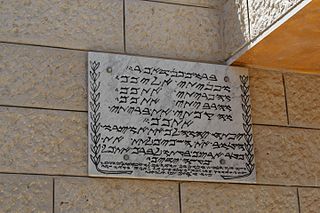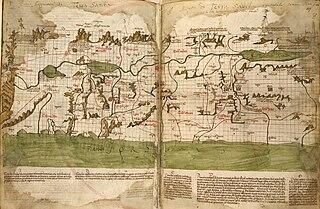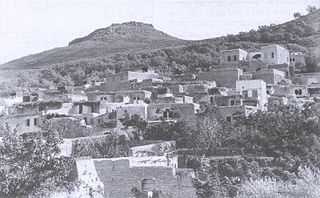Related Research Articles

The Samaritan religion, also known as Samaritanism, is the national religion of the Samaritans. The Samaritans adhere to the Samaritan Torah, which they believe is the original, unchanged Torah, as opposed to the Torah used by Jews. In addition to the Samaritan Torah, Samaritans also revere their version of the Book of Joshua and recognize some Biblical figures, such as Eli.

The Talmud is the central text of Rabbinic Judaism and the primary source of Jewish religious law (halakha) and Jewish theology. Until the advent of modernity, in nearly all Jewish communities, the Talmud was the centerpiece of Jewish cultural life and was foundational to "all Jewish thought and aspirations", serving also as "the guide for the daily life" of Jews.
The Pharisees were a social movement and a school of thought in the Levant during the time of Second Temple Judaism. After the destruction of the Second Temple in 70 CE, Pharisaic beliefs became the foundational, liturgical, and ritualistic basis for Rabbinic Judaism.

The Holy Land is an area roughly located between the Jordan River and the Mediterranean Sea that also includes the Eastern Bank of the Jordan River. Traditionally, it is synonymous both with the biblical Land of Israel and with the region of Palestine. The term "Holy Land" usually refers to a territory roughly corresponding to the modern State of Israel, the Palestinian territories, western Jordan, and parts of southern Lebanon and of southwestern Syria. Jews, Christians, and Muslims all regard it as holy.

Kafr ʿInān, was a Palestinian Arab village in the Acre Subdistrict around 33 kilometres (21 mi) east of Acre. Until 1949, it was an Arab village built over the ruins of ancient Kefar Hanania. Archaeological surveys indicate Kefar Hanania was founded in the Early Roman period, and was inhabited through the Byzantine period. It was resettled in the Middle Ages and the modern era.

Lod is a city 15 km (9.3 mi) southeast of Tel Aviv in the Central District of Israel. In 2019 it had a population of 77,223.

Hittin was a Palestinian village located 8 kilometers (5 mi) west of Tiberias. As the site of the Battle of Hattin in 1187, in which Saladin conquered most of Palestine from the Crusaders, it has become an Arab nationalist symbol. The shrine of Nabi Shu'ayb, venerated by the Druze and Sunni Muslims as the tomb of Jethro, is on the village land. The village was ruled by the Ottoman Empire from the 16th century until the end of World War I, when Palestine became part of the British Mandate for Palestine. In the 1948 Arab-Israeli war, the village was depopulated.
Tannaim were the rabbinic sages whose views are recorded in the Mishnah, from approximately 10–220 CE. The period of the Tannaim, also referred to as the Mishnaic period, lasted about 210 years. It came after the period of the Zugot ("pairs"), and was immediately followed by the period of the Amoraim ("interpreters").

Palestine is a geographic region in Western Asia usually considered to include Israel, the West Bank, the Gaza Strip, and in some definitions, parts of western Jordan.
Clopas is a figure of early Christianity. The name appears in the New Testament, specifically in John 19:25:
Near the cross of Jesus stood his mother, his mother's sister, Mary the wife of Clopas, and Mary Magdalene.

Generically, a Galilean is an inhabitant of Galilee, a region of Palestine surrounding the Sea of Galilee. The New Testament notes that the Apostle Peter's accent gave him away as a Galilean. The Galilean dialect referred to in the New Testament was a form of Jewish Palestinian Aramaic spoken by people in Galilee from the late Second Temple period (530 BCE) through the Apostolic Age (c. 100 CE). Later the term was used to refer to the early Christians by Roman emperors Julian and Marcus Aurelius, among others.

Asenath Barzani (1590–1670), was a renowned Kurdish and Jewish woman who lived in Iraq. Her writings demonstrate her mastery of Hebrew, Torah, Talmud, Midrash, and Kabbalah.

Daniel Sperber is a British-born Israeli academic and open orthodox rabbi. He is a professor of Talmud at Bar-Ilan University in Israel, and an expert in classical philology, history of Jewish customs, Jewish art history and experienced in Jewish education.

As Samu' or es-Samu' is a town in the Hebron Governorate of the West Bank, Palestine, 12 kilometers south of the city of Hebron and 60 kilometers southwest of Jerusalem.

Jimzu, also known as Gimzo, was a Palestinian village, located three miles southeast of Lydda. Under the 1947 UN Partition Plan of Mandatory Palestine, Jimzu was to form part of the proposed Arab state. During the 1948 Arab–Israeli War, the village was depopulated in a two-day assault by Israeli forces.

Akbara is an Arab neighborhood in the Israeli municipality of Safed, which included in 2010 more than 200 families. It is 2.5 km south of Safed City. The village was built by the state of Israel in 1977, close to the old village destroyed in 1948 during the Israeli war of independence.

The Eshtemoa Synagogue, located 15 km south of Hebron in as-Samu, West Bank, refers to the remains of an ancient Jewish synagogue dating from around the 4th–5th century CE.
Palestinian rabbis encompasses all rabbis who lived in the region known as Palestine up until modern times, but most significantly refers to the early Jewish sages who dwelled in the ancient Holy Land and compiled the Mishna and its later commentary, the Jerusalem Talmud. These rabbis lived between 150 BCE and 400 CE and during the Talmudic and later Geonic period, they exerted influence over Syria and Egypt, while the authorities in Babylonia had held sway over the Jews of Iraq and Iran. While the Jerusalem Talmud was not to become authoritative against the Babylonian, the liturgy developed by Palestinian rabbis was later destined to form the foundation of the minhag of nearly all the Ashkenazic communities across Europe.

Yoram Tsafrir was an Israeli archaeologist. His research has included the Byzantine influence on ancient synagogues, demography of Palestine in the Byzantine period, mosaics at Horvat Berachot, excavations at Beit She'an, and excavations at Rehoboth. A Professor Emeritus of the Institute of Archaeology at the Hebrew University of Jerusalem, he was a member of the Israel Academy of Sciences and Humanities.
Hayim Lapin is an American Jewish studies and history scholar, currently Robert H. Smith Professor of Jewish Studies and History and director of the Joseph and Rebecca Meyerhoff Program and Center for Jewish Studies at the University of Maryland, College Park.
References
- ↑ Ben-Zion Rosenfeld (2009). Torah Centers and Rabbinic Activity in Palestine 70-400 C.e: History and Geographic Distribution. BRILL. p. 81. ISBN 978-90-04-17838-0 . Retrieved 12 June 2011.
- ↑ Ben-Zion Rosenfeld (2009). Torah Centers and Rabbinic Activity in Palestine 70-400 C.e: History and Geographic Distribution. BRILL. p. 105. ISBN 978-90-04-17838-0 . Retrieved 12 June 2011.
| | This biographical article about a rabbi from the Middle East is a stub. You can help Wikipedia by expanding it. |